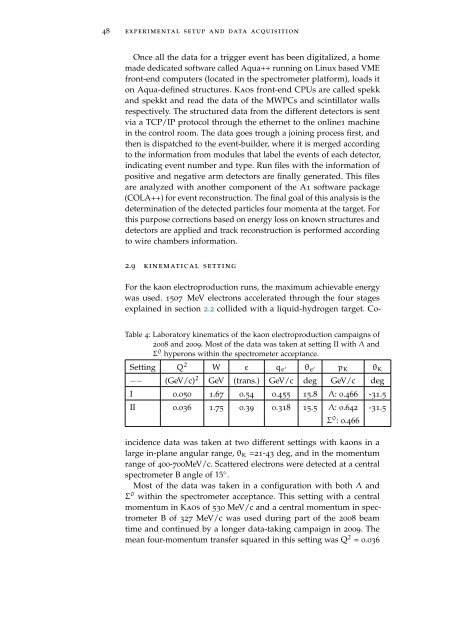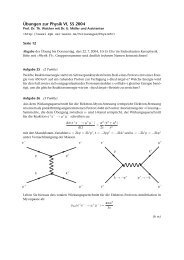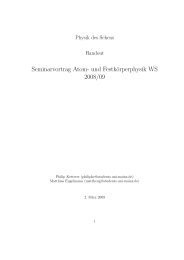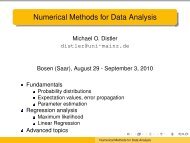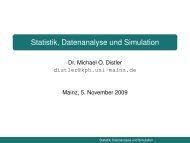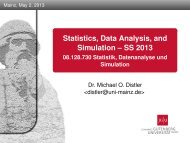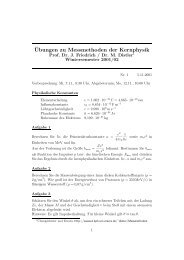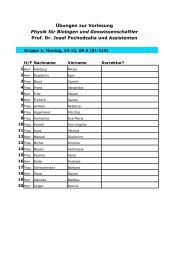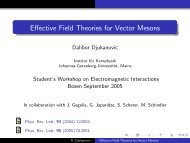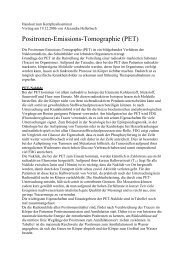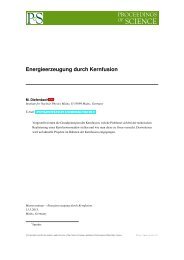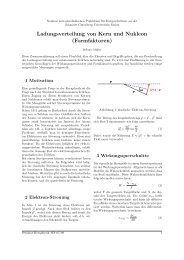A Classic Thesis Style - Johannes Gutenberg-Universität Mainz
A Classic Thesis Style - Johannes Gutenberg-Universität Mainz
A Classic Thesis Style - Johannes Gutenberg-Universität Mainz
You also want an ePaper? Increase the reach of your titles
YUMPU automatically turns print PDFs into web optimized ePapers that Google loves.
48 experimental setup and data acquisition<br />
Once all the data for a trigger event has been digitalized, a home<br />
made dedicated software called Aqua++ running on Linux based VME<br />
front-end computers (located in the spectrometer platform), loads it<br />
on Aqua-defined structures. Kaos front-end CPUs are called spekk<br />
and spekkt and read the data of the MWPCs and scintillator walls<br />
respectively. The structured data from the different detectors is sent<br />
via a TCP/IP protocol through the ethernet to the online1 machine<br />
in the control room. The data goes trough a joining process first, and<br />
then is dispatched to the event-builder, where it is merged according<br />
to the information from modules that label the events of each detector,<br />
indicating event number and type. Run files with the information of<br />
positive and negative arm detectors are finally generated. This files<br />
are analyzed with another component of the A1 software package<br />
(COLA++) for event reconstruction. The final goal of this analysis is the<br />
determination of the detected particles four momenta at the target. For<br />
this purpose corrections based on energy loss on known structures and<br />
detectors are applied and track reconstruction is performed according<br />
to wire chambers information.<br />
2.9 kinematical setting<br />
For the kaon electroproduction runs, the maximum achievable energy<br />
was used. 1507 MeV electrons accelerated through the four stages<br />
explained in section 2.2 collided with a liquid-hydrogen target. Co-<br />
Table 4: Laboratory kinematics of the kaon electroproduction campaigns of<br />
2008 and 2009. Most of the data was taken at setting II with Λ and<br />
Σ 0 hyperons within the spectrometer acceptance.<br />
Setting Q 2 W ɛ qe ′ θe ′ pK θK<br />
−− (GeV/c) 2 GeV (trans.) GeV/c deg GeV/c deg<br />
I 0.050 1.67 0.54 0.455 15.8 Λ: 0.466 -31.5<br />
II 0.036 1.75 0.39 0.318 15.5 Λ: 0.642 -31.5<br />
Σ 0 : 0.466<br />
incidence data was taken at two different settings with kaons in a<br />
large in-plane angular range, θK =21-43 deg, and in the momentum<br />
range of 400-700MeV/c. Scattered electrons were detected at a central<br />
spectrometer B angle of 15 ◦ .<br />
Most of the data was taken in a configuration with both Λ and<br />
Σ 0 within the spectrometer acceptance. This setting with a central<br />
momentum in Kaos of 530 MeV/c and a central momentum in spectrometer<br />
B of 327 MeV/c was used during part of the 2008 beam<br />
time and continued by a longer data-taking campaign in 2009. The<br />
mean four-momentum transfer squared in this setting was Q 2 = 0.036


